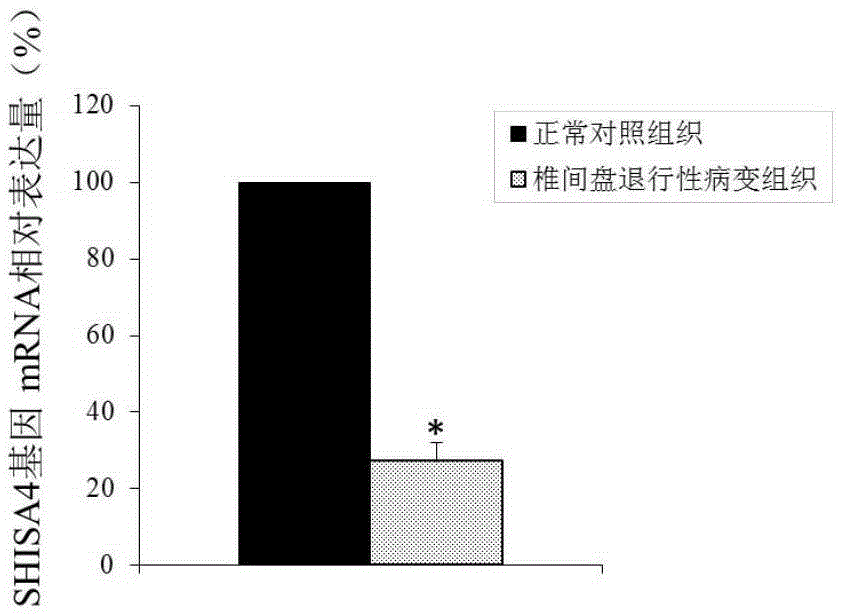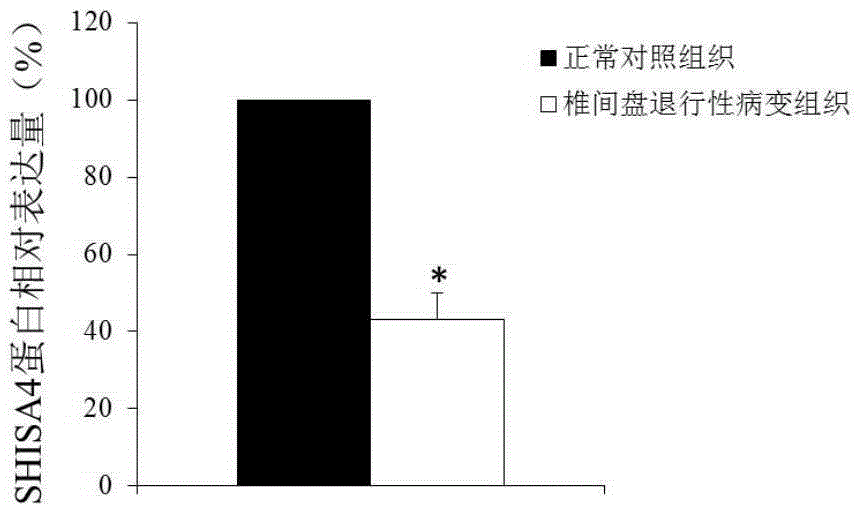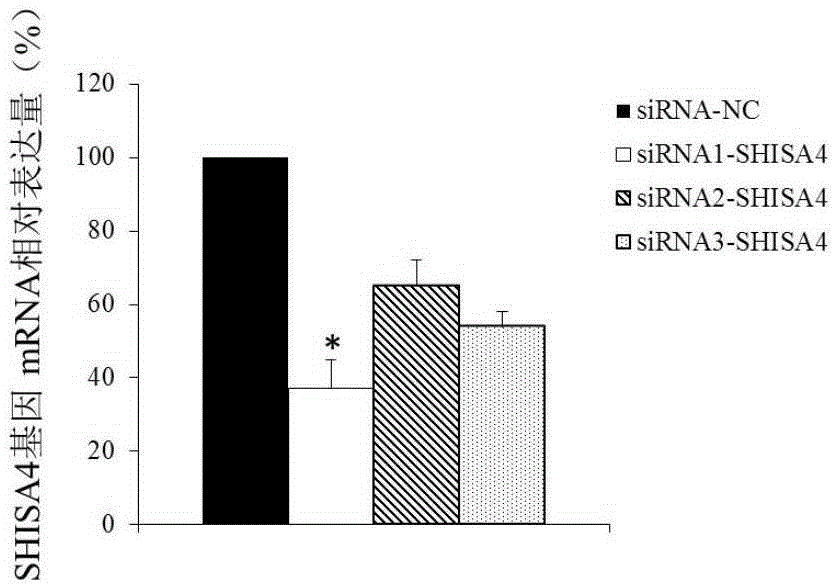Application of gene SHISA4 as intervertebral disc degenerative change diagnosis and treatment marker
A technology for degenerative diseases and intervertebral discs, which can be applied in gene therapy, disease diagnosis, microbial measurement/testing, etc., and can solve the problems that the pathogenesis has not been clearly elucidated
- Summary
- Abstract
- Description
- Claims
- Application Information
AI Technical Summary
Problems solved by technology
Method used
Image
Examples
Embodiment 1
[0061] Example 1 Difference of SHISA4 gene expression in degenerative disc tissues and normal control tissues
[0062] 1. Sample collection
[0063] 40 cases of normal human intervertebral disc tissue were taken from patients with traumatic spinal burst fractures. Take 40 cases of intervertebral disc tissue from patients with degenerative disc disease, with an average age of 75 years. According to the Gr1es [5] scoring standard, they are all severely degenerated. The patients and their family members agreed to the sample collection.
[0064] 2. Extraction of nucleus pulposus tissue
[0065] Normal nucleus pulposus tissue: The normal intervertebral disc tissues were removed completely by the operation, and the white fibrous ring on the periphery and the jelly-like nucleus pulposus tissue in the center were visible. Soak the intervertebral disc with normal saline containing double antibody (penicillin-streptomycin) for 10 minutes. Use a curette to gently separate the nucleus pulposus ...
Embodiment 2
[0089] Example 2 Interference with SHISA4 gene expression
[0090] 1. siRNA design and synthesis
[0091] SiRNA sequence against SHISA4:
[0092] siRNA1-SHISA4:
[0093] The sense strand is 5'-UGUCUUUACAGCUUUAAUCUA-3' (SEQIDNO.3);
[0094] The antisense strand is 5'-GAUUAAAGCUGUAAAGACAUA-3' (SEQIDNO.4),
[0095] siRNA2-SHISA4:
[0096] The sense strand is 5'-UCUUUAGGAAGCCUUUAGGAA-3' (SEQIDNO.5);
[0097] The antisense strand is 5'-CCUAAAGGCUUCCUAAAGACA-3' (SEQIDNO.6),
[0098] siRNA3-SHISA4:
[0099] The sense chain is 5'-UGUUGUAGAGCUGUUGAUCCC-3' (SEQIDNO.7);
[0100] The antisense strand is 5’-GAUCAACAGCUCUACAACAGC-3’ (SEQIDNO.8)
[0101] Negative control siRNA sequence (siRNA-NC):
[0102] The sense strand is 5'-CGUACGCGGAAUACUUCGA-3' (SEQIDNO.9);
[0103] The antisense strand is 5'-UCGAAGUAUUCCGCGUACG-3' (SEQ ID NO. 10).
[0104] 2. Cell culture
[0105] Put the intervertebral disc nucleus pulposus tissue into a 100ml beaker containing 10m12% type II collagenase, and stir for about 60 minutes w...
Embodiment 3
[0122] Example 3 Effect of SHISA4 gene expression on the proliferation of nucleus pulposus cells
[0123] 1. Use CellCountingkit-8 (cck-8) kit to detect the proliferation of nucleus pulposus cells
[0124] 1.1 steps
[0125] The normal nucleus pulposus cells were cultured and transfected according to the method of Example 2. The cells were divided into three experimental groups:
[0126] Group 1: Cells were transfected with siRNA-NC as a control group;
[0127] Group 2: Cells were transfected with siRNA1-SHISA4.
[0128] 24h after transfection, 2×10 5 / ml density inoculated in 96-well cell culture plates, each experimental group designed three multiple wells, each well 100μl, placed in 37 ℃, 5% CO 2 After incubating in the incubator for 24 hours, add 10μl of CK-8 solution to each well of the culture wells to be tested, and incubate for 1 hour in the cell incubator, and measure the absorbance (OD) of each well at 450nm.
[0129] 1.2 Statistical methods
[0130] The experiment was repeated 3...
PUM
 Login to View More
Login to View More Abstract
Description
Claims
Application Information
 Login to View More
Login to View More - R&D
- Intellectual Property
- Life Sciences
- Materials
- Tech Scout
- Unparalleled Data Quality
- Higher Quality Content
- 60% Fewer Hallucinations
Browse by: Latest US Patents, China's latest patents, Technical Efficacy Thesaurus, Application Domain, Technology Topic, Popular Technical Reports.
© 2025 PatSnap. All rights reserved.Legal|Privacy policy|Modern Slavery Act Transparency Statement|Sitemap|About US| Contact US: help@patsnap.com



